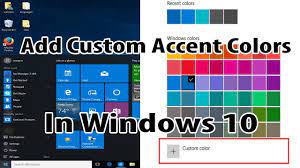Unveiling the Art of Adding Accents in Windows 10: A Comprehensive Guide

In today’s interconnected world, communication knows no bounds. Whether you’re writing a formal document, crafting an email, or chatting with friends, adding accents to characters can enhance clarity, accuracy, and cultural sensitivity. Windows 10, as a versatile operating system, offers a multitude of methods to seamlessly incorporate accents into your writing, ensuring your messages are polished and precise. In this comprehensive guide, we’ll explore various techniques and tools available in Windows 10 to effortlessly add accents to your text.
Why Accents Matter
Accents serve several essential purposes in written communication:
- Clarity: Accents can distinguish between homographs (words that are spelled the same but have different meanings), ensuring your message is accurately conveyed.
- Accuracy: When writing in languages with diacritical marks, such as French or Spanish, accents are crucial for spelling words correctly.
- Cultural Sensitivity: Including accents demonstrates respect for linguistic diversity and cultural nuances, fostering better understanding and appreciation.
Method 1: Using Keyboard Shortcuts
Windows 10 provides convenient keyboard shortcuts for adding accents to characters without the need for special software or configurations. These shortcuts are simple to memorize and can significantly streamline your writing process. Here’s how to use keyboard shortcuts to add accents:
- Accent Marks with Alt Codes: Press and hold the
Altkey while typing the corresponding numeric code using the numeric keypad (ensure Num Lock is on). For example:Alt + 0233produces é (e with acute accent).Alt + 0243produces ó (o with acute accent).
- International Keyboard Layouts: Switch to an international keyboard layout that supports accents. For example, the United States-International keyboard layout allows you to type accents by pressing specific keys in combination with the right Alt key. For instance:
'followed byeproduces é.~followed bynproduces ñ.
Method 2: Windows Character Map
The Character Map is a built-in utility in Windows 10 that allows users to browse and insert a wide range of characters, including accents, symbols, and special characters. Here’s how to access and use the Character Map:
- Press
Windows + Sto open the search bar, then type “Character Map” and pressEnter. - In the Character Map window, browse or search for the desired character, such as é or ç.
- Click on the character to select it, then click the “Select” button followed by “Copy” to copy the character to your clipboard.
- Paste the character into your document or text field using
Ctrl + V.
Method 3: Language Settings and Input Methods
Windows 10 supports multiple languages and input methods, allowing users to seamlessly switch between keyboards tailored to different languages or regions. By adding language keyboards to your system, you gain access to accents specific to those languages. Here’s how to add language keyboards in Windows 10:
- Open the Settings app by pressing
Windows + I. - Go to “Time & Language” and select “Language” from the sidebar.
- Under “Preferred languages,” click “Add a language” and choose the desired language from the list.
- Once added, click on the language, then click “Options” and select “Add a keyboard” to add a keyboard layout for that language.
- Switch between keyboard layouts using the language bar or by pressing
Windows + Space.
Conclusion
In conclusion, adding accents in Windows 10 is a simple yet invaluable skill for enhancing written communication. Whether you’re writing in multiple languages, communicating with international colleagues, or simply striving for accuracy and clarity, Windows 10 offers an array of tools and methods to seamlessly incorporate accents into your text. By mastering keyboard shortcuts, leveraging the Character Map utility, and exploring language settings and input methods, you can elevate your writing and demonstrate cultural sensitivity with ease. With these techniques at your disposal, you’ll be well-equipped to craft polished and precise messages that resonate across linguistic boundaries.







